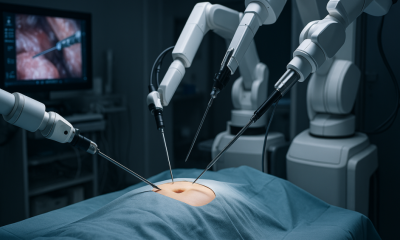Robotics
Assembler Robots Can Piece Together Large Structures

There is new work being done with assembler robots at the Massachusetts Institute of Technology. Professor Neil Gershenfeld and graduate student Benjamin Jennett have been working in MIT’s Center for Bits and Atoms (CBA) to create prototype versions of the robots. The small robots are capable of assembling small structures, and they coordinate with each other to piece together the smaller structures into larger pieces.
These new developments can have big implications for certain industries such as commercial aircrafts. As of right now, commercial aircrafts are often assembled piece by piece. Those pieces are built at different locations, and they eventually meet up at one spot to be assembled. With this new technology, the entire commercial aircraft can be assembled in the same place by the small robots.
The new developments were published in the October issue of the IEEE Robotics and Automation Letters. The paper was compiled by Professor Gershenfeld, Jennett, and graduate student Amira Abdel-Rahman. It was also worked on by CBA alumnus Kenneth Cheung, who now works in the Amers Research Center at NASA. It is there where Cheung runs the ARMADAS project, which focuses on designing a lunar base that can be built through robotic assembly.
“What's at the heart of this is a new kind of robotics, that we call relative robots,” Gershenfeld says.
Two Categories of Robots
According to Gershenfeld, there are two broad categories of robotics, The first are made out of expensive, custom components that are specifically optimized for applications like factory assembly. The second are inexpensive, mass-produced ones with lower performance.
The new assembler robots are neither; they are simpler, more capable, and they can change everything we know about production for items such as airplanes, bridges, and buildings.
The big difference with these assembler robots is that they have a different system for how the robotic device interacts with the materials that it is handling.
“You can’t separate the robot from the structure — they work together as a system,” Gershenfeld says.
Instead of keeping track of their position through the use of navigation systems, the assembler robots use the small subunits, or voxels. With each step onto the next voxel, the assembler robot can readjust its sense of position.
The team wants to have any physical object capable of being recreated as an array of smaller voxels, consisting of simple struts and nodes. The simple components can then distribute different loads based on their arrangement, and the overall weight of the object will be lighter since the voxels will mostly consist of empty space. Each voxel will have a latching system built into it so that they can all stay together.
Simplifying Complex Robotic Systems
As the voxel assembles pieces, it is able to count its steps over the structure. This, along with the navigation technique, simplifies the current complex robotic systems.
“It's missing most of the usual control systems, but as long as it doesn't miss a step, it knows where it is,” Gershenfeld says.
Abdel-Rahman developed control software that helps make the process faster by bringing together swarms of units, which help the robots coordinate and work together.
Big Interest By Big Names
There is already a lot of interest in the technology by big names such as NASA and the European aerospace company Airbus SE.
One of the advantages of the assembler robots is that they allow the repairs and maintenance of a structure to follow the same robotic process as the initial assembly. Damaged parts of the structure can be replaced and fixed, and this allows it to stay in the same place instead of being split up.
According to Gershenfeld, “Unbuilding is as important as building.”
“For a space station or a lunar habitat, these robots would live on the structure, continuously maintaining and repairing it,” says Jenett.
These new developments will have huge implications for almost every structure and its construction process, including entire buildings. According to the team, It can even be used in difficult environments like space, the moon, or Mars. Instead of taking huge structures and sending them into space, large numbers of smaller pieces could be sent and then assembled by the robots. Even better, the natural resources could be used in whatever place the subunits go.
Enormous Potential and Problems
While acknowledging the enormous potential of this technology and how it will change our society, it is also worth noting that it will have huge implications for the economy as well. With the use of robotics and artificial intelligence, the need for humans to build, create, and develop is becoming less important. If we do not proceed with caution, these new technologies will come with enormous problems.











